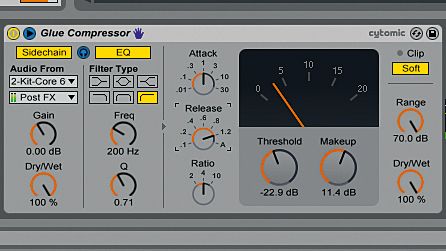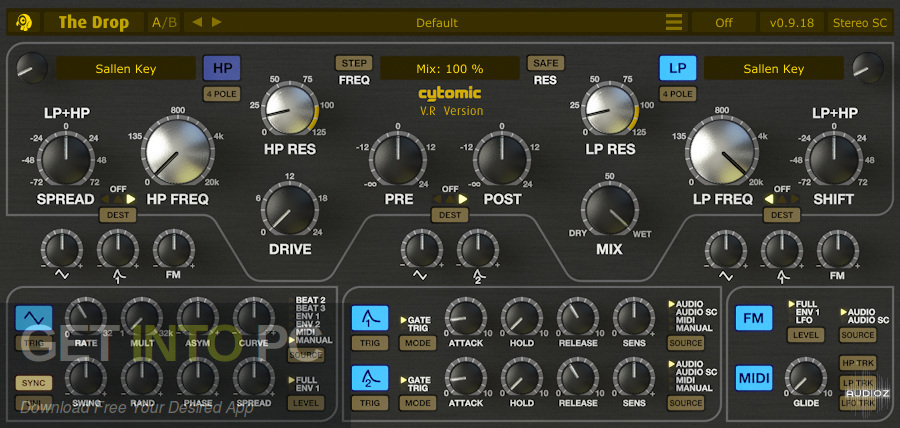

- CYTOMIC THE GLUE FOR MASTERING ELECTRONIC UPDATE
- CYTOMIC THE GLUE FOR MASTERING ELECTRONIC SOFTWARE
- CYTOMIC THE GLUE FOR MASTERING ELECTRONIC SERIES
There’s a lot here: new Cytomic-modeled analogue-style filters a redesigned Simpler a completely new cross-app wireless sync protocol called Link GUI enhancements like better waveform accuracy and scrolling, updated meters that show both Peak and RMS at once and clip colours automatically taking on the hue of their parent track.
CYTOMIC THE GLUE FOR MASTERING ELECTRONIC UPDATE
Remember with the master buss, your aim is to shave 2dB or so, not squash things.Ableton has dropped a 9.5 update for Live. Usually you need to follow this with a brickwall limiter in case any of those transients are too sharp. This is called 'new york style' parallel compression and it can bring some transients back by mixing 10-20% dry signal back into the mix. You can experiment backing off wet, but I wouldn't go below 50%. This will keep the kick from causing a 'pumping effect'. Next adjust the make-up gain to bring your levels back to where they were.Īnother trick others have mentioned is to highpass the entire mix around 80 to 100hz and then run that to the side-chain of the compressor.

If it's bouncing too much, between loud and soft, increase the ratio and try again. Loop your track and slowly bring down the threshold until the gain reduction meter is showing a consistent -1 to -2dB and not going any more than say -5dB. Then set the threshold to max and the make-up gain to 0dB. Start with the wet at 100%, the release on Auto, the ratio at 2, clip on soft, range max (70). The glue compressor is already kind of slow so this isn't really a problem. I will use a relatively fast attack time, like close to minimum. I'd say most of the commenters here are talking about "glueing" settings but if you're looking for "ducking" settings make sure that is clear. There's a bit of overlap between the two concepts when applied to a bus track but ducking tends to use more extreme voluem reduction and is often applied to a single audo source/track whereas gluing uses milder volume reduction and only makes sense on group buses or master tracks. Because all of the input sounds to the bus/master track have their volume reduced by the loudest sounds they sound like they are in the same place, or "glued" together. Gluing is when you put a compressor on a bus or master track with the settings chosen to give small-to-medium volume reduction across all of the tracks playing through the bus/master track when the loudest sounds hit. This is usually done on individual or bus tracks with synths or vocals, not so much on the master unless you're going for that way overplayed Eric Prydz sound. your kick or a click track, so that it triggers the the compressor for a short time causing a short volume reduction on the track you have the compressor on. "ducking" and "gluing" are two different things.ĭucking is achieved by side chaining an input source, e.g. Please use flair if you would like to share your pages.įor example I'm not sure what to set for the ratio, attack, release and threshold to get that ducking sound when the kick is going.

CYTOMIC THE GLUE FOR MASTERING ELECTRONIC SOFTWARE

Hosted by u/rarebiird New episodes 3rd week of the month.
CYTOMIC THE GLUE FOR MASTERING ELECTRONIC SERIES
To technofy is to become aware of the coevolution of machine and human, the secret life of machines, the computerization of the world, the programming of history, the informatics of reality.Kodwo Eshun, More Brilliant Than The Sun 1998, p.103 Regular EventsĪIR is an interview podcast series with a different theme each episode. Press PATTERN CLEAR for rhythmatic synthesis. Press the ENTER button on the Roland composer. it's necessary to technofy first yourself, then the world.


 0 kommentar(er)
0 kommentar(er)
